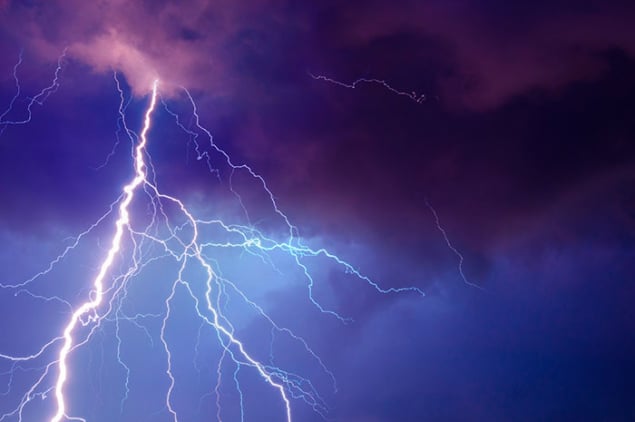
The first detailed, convincing evidence that lightning strikes can lead to the synthesis of radioactive isotopes in the atmosphere has been unveiled by physicists in Japan. The research, which was initially financed by crowdfunding, follows several previous, inconclusive observations and confirms a theoretical prediction that gamma rays produced during lightning strikes can stimulate a variety of nuclear reactions, releasing neutrons and positrons into the atmosphere.
Gamma rays can be produced by lightning strikes when relativistic electrons, accelerated by strong electric fields, lose energy in collisions with air molecules. Dubbed gamma-ray flashes, these events are usually directed up towards outer space. Indeed, the first detections of gamma rays from lightning were made by satellites. However, scientists have recently discovered that, on rare occasions, the gamma rays can instead shoot down at Earth. Several research groups have detected neutrons or positrons in the atmosphere in the aftermath of lightning strikes. Theoretical models have associated these with the gamma ray-induced production and subsequent decay of radioactive nuclei such as nitrogen-13 and oxygen-15. However, no conclusive evidence had previously been found to confirm this.
Teruaki Enoto of Kyoto University in Japan and colleagues have been operating radiation detectors at Japan’s Kashiwazaki-Kariwa nuclear power station since 2006 in an effort to detect gamma ray emissions from the heavy, low thunderclouds that are common to the region. On 6 February they got lucky: their four detectors recorded powerful discharges from two simultaneous lightning strikes less that 2 km away. In the immediate aftermath of the strikes, the researchers detected a gamma-ray “afterglow” lasting a few hundred milliseconds. They attribute this to gamma-ray photons generated in the initial lightning strike having knocked neutrons out of stable atoms in the air such as nitrogen-14. Some of these neutrons were then captured by other nuclei, they conclude, producing excited states, which subsequently decayed – explaining the delayed gamma-ray photons of the afterglow. This conclusion is supported by research reported last month in Geophysical Research Letters, which shows unambiguous direct detection of neutrons from a downward gamma-ray flash.
After the afterglow
After the initial afterglow had died away, the researchers detected a second signal in detectors downwind of the lightning strikes that emerged slowly and peaked after about 1 min. Tellingly, this signal showed a strong peak at an energy of 0.51 MeV – almost exactly the energy of gamma rays produced by electron-positron annihilation. The researchers concluded, therefore, that this signal was the result of the inverse beta decay of the radioactive nuclei that had been produced when the gamma-ray photons had knocked neutrons out of stable atoms. Nitrogen-13, for example, decays to stable carbon-13 by emitting a positron with a half-life of 10 min.

When the researchers studied the direction and speed of the wind on the day of the lightning strikes, they found that the time taken for this second signal to peak coincided with the time it would have taken for air around the lightning strikes to blow over the detectors. “Our discovery is the first time that neutrons and positrons have both been detected simultaneously from the same event with enough subsequent interpretation of both signals,” says Enoto. “We interpreted the dataset very carefully and our results cannot be interpreted other ways.”
Joseph Dwyer of the University of New Hampshire in the US, who was not involved in the Kashiwazaki-Kariwa study but is a co-author on the Geophysical Research Letters paper, says that the new research fills in a crucial piece of the puzzle. “We’ve seen the gamma rays, we’ve seen the neutrons, we should be seeing these radioactive decays, and that’s what they’ve seen,” he says. “This paper is throwing in the missing part of the painting…If we never saw these radioactive by-products it would be a big problem for our current understanding.”
Much to be done
Nevertheless, he says, there is still much work to be done: “There’s a lot of things about thunderstorms and lightning we really don’t understand, but in the mix we know that sometimes thunderstorms make these powerful bursts of gamma rays. We know it’s somehow related to lightning and the strong electric fields, so it’s telling us something really interesting is going on at the time, but we’re not certain about exactly what’s happening.”
The research is described in Nature.



